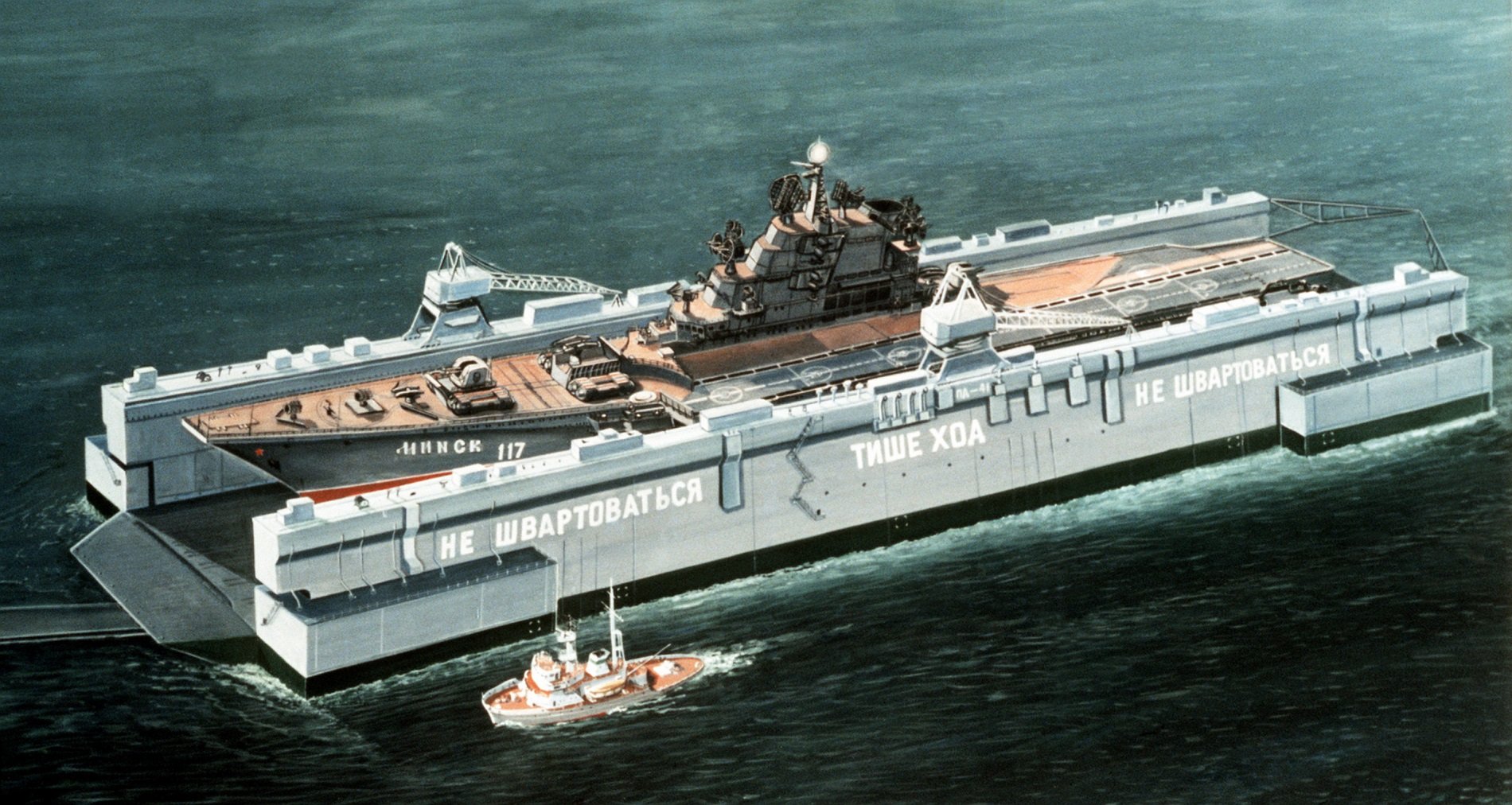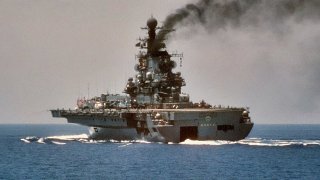Russia Tried to Merge a Cruiser and Aircraft Carrier. It Ended Up in China
Decommissioned after the collapse of the USSR, Minsk was sold to China, where it became a theme park, symbolizing the failure of Soviet ambitions to rival American naval air power.
Summary and What You Need to Know: The Soviet Navy's Minsk, a Kiev-class aircraft carrier, was a hybrid between a cruiser and an aircraft carrier, featuring limited aircraft capabilities and heavy missile armament.
-Designed to rival U.S. carriers, Minsk could only carry 12 Yak-38 VTOL warplanes and 16 helicopters.
-Despite its significant firepower, the ship’s design reflected a transition in Soviet naval strategy rather than an effective carrier force.
-Decommissioned after the collapse of the USSR, Minsk was sold to China, where it became a theme park, symbolizing the failure of Soviet ambitions to rival American naval air power.
The Minsk was a Soviet Navy era aircraft carrier that was the second warship of the Kiev-class carriers. To call these platforms aircraft carriers does a disservice to the aircraft carriers that most Americans are used to seeing when they think of flat tops. This was not a large, flat-decked warship that deployed dozens of warplanes and helicopters.
Instead, this was a hybrid of a cruiser and a carrier. It was the spork of an aircraft carrier: it looked like a cruiser with a platform for launching and recovering a limited number of aircraft.
Not Being Who You Are
The Soviet warship Minsk was built at the Black Sea Shipyard in Nikolayev, Ukraine. It was commissioned in 1978. The Soviets were intent on proving to everyone that they could build a big, bad aircraft carrier just like the Americans could. Of course, Moscow wasn’t playing to type. In some cases, that’s a good thing. It’s always helpful to expand one’s horizons by learning new things.
Then again, however, in the midst of a Cold War, when there is a nuclear competition between two opposing Superpowers, wasting precious time and resources pretending to be something you’re not is usually a mistake.
Such as it was with the Soviet attempts to build an aircraft carrier for their navy. The Soviet, and modern-day Russian, expertise at sea boils down to submarines. Its surface fleet looks more like that of a great regional power rather than a superpower. That’s okay because historically Russia is a continental power. It is one of the largest nations in the world in terms of land area. Russia possesses a limited amount of warm water ports from which to permanently deploy its naval forces.
Nevertheless, in the last half of the Cold War, Moscow became obsessed with matching the Americans, system-for-system. In fact, this commitment to cloning the US military—when the Russians have their own unique culture, history, and way of warfare—is one of the reasons why the Soviet Union ultimately spent itself into oblivion.
Serious Firepower for Minsk Aircraft Carrier
The Minsk was equipped with some serious power, though (as most Soviet surface warships were). These boats had four twin SS-N-12 Sandbox surface-to-surface missile launchers, two twin SA-N-3 Shtorm surface-to-air missile launchers, and two twin SA-N-4 Gecko air defenses missile launchers. It also had a variety of guns, torpedoes, and anti-submarine launchers.
Essentially, this so-called aircraft was built to fire a massive missile farm.
Minsk was designed to carry up to 30 aircraft. But given its smaller landing deck (compared to American flat tops), the warplanes it carried had to have a vertical-takeoff and landing (VTOL) capability. In this case, the Yak-38 warplane was the primary warplane deployed from the Minsk. And as I’ve noted elsewhere, the Yak-38 was most definitely a subpar warplane. What’s more, only 12 Yak-38s could be carried aboard the Minsk. In fact, the Minsk carried more helicopters (16) than warplanes.
Russia’s Minsk had a crew capacity between 1,200 and 1,600 sailors. The warship had a range of 13,500 nautical miles (15,535 miles) and could cruise along the surface of the ocean at 18 knots (20 miles per hour). Not bad for such a large ship carrying such a heavy load.
A Transition for the Russians
While the Minsk (and its sister Kiev-class warships) were definitely not the cream of the crop when it came to aircraft carriers, the fact is that they represented a real shift in Soviet strategic thinking.
There was a significant desire on the part of late-stage Soviet leaders to not just make the Red Navy into a real maritime force, but to rival the Americans in terms of aircraft carrier operations and capabilities. The fact that the Minsk and its sister ship were hybrids between a cruiser and aircraft carrier, while inefficient for effective carrier operations, indicated that the Reds were trying make the change and that this was but a transition system.

Indeed, the Soviets would go on to develop a legitimate aircraft carrier—the Admiral Kuznetsov. But that flat top may be the single worst carrier ever designed in the history of aircraft carriers. Nevertheless, the Reds were clearly committed to becoming an aircraft carrier power and the Minsk and Kiev-class was the pathway forward for them.
That it went nowhere is less an indication of perennial inability by the Russians and more because the USSR collapsed. Following the collapse, Moscow had to focus on its core capabilities—of which the carrier was not a part.
An Ignominious End
On June 30, 1993, the Minsk was decommissioned a couple of years after the collapse of the USSR. It was later sold to China in 1995, where the Chinese turned the old Soviet warship into a theme park called “Minsk World” in Shenzhen, China. Talk about an ignominious end for a once powerful, prized warship belonging to one of the two world’s superpowers!
Bottom line: the Minsk carrier was one of a handful of attempts by the old Soviet Union to build a big, bad carrier to rival that of the Americans. Ultimately, this boat was just bad. Sure, it had some impressive features and armaments. And, in the tighter regions where Russian maritime power could actually be reliably projected—such as the Black Sea or the Baltic Sea—this boat could hold its own.
But its record of success during the course of its service to Russia was very limited. Once it was decommissioned and sold to a foreign power, rather than being retooled and deployed as part of that foreign power’s navy, it was converted into a theme park.
Author Experience and Expertise: Brandon J. Weichert
Brandon J. Weichert, a National Interest national security analyst, is a former Congressional staffer and geopolitical analyst who is a contributor at The Washington Times, the Asia Times, and The-Pipeline. He is the author of Winning Space: How America Remains a Superpower, Biohacked: China’s Race to Control Life, and The Shadow War: Iran’s Quest for Supremacy. His next book, A Disaster of Our Own Making: How the West Lost Ukraine, is due October 22 from Encounter Books. Weichert can be followed via Twitter @WeTheBrandon.
All images are Creative Commons.
From The Vault


